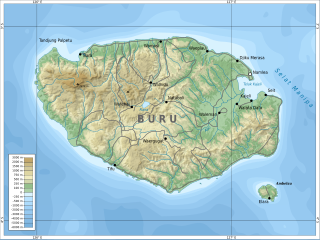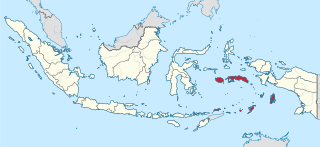Provinces of Indonesia are the 34 largest subdivisions of the Indonesia and the highest tier of the local government. Provinces are further divided into regencies and cities, which are in turn subdivided into districts (kecamatan).

Seram is the largest and main island of Maluku province of Indonesia, despite Ambon Island's historical importance. It is located just north of the smaller Ambon Island and a few other surrounding islands, such as Haruku, Geser, Nusalaut, Banda and Saparua.

West Papua, formerly Irian Jaya Barat or Irian Barat, is a province of Indonesia. It covers the two western peninsulas of the island of New Guinea, Bird's Head Peninsula and Bomberai Peninsula, along with nearby islands. The province is bordered to the north by the Pacific Ocean, to the west by the Halmahera Sea and the Ceram Sea, to the south by the Banda Sea, and to the east by the province of Papua and the Cenderawasih Bay. Manokwari is the province's capital, while Sorong is its largest city. West Papua is the second-least populous province in Indonesia, with a population of 1,134,068 at the 2020 Census.

Buru is the third largest island within Maluku Islands of Indonesia. It lies between the Banda Sea to the south and Seram Sea to the north, west of Ambon and Seram islands. The island belongs to Maluku province and includes the Buru and South Buru regencies. Their administrative centers, Namlea and Namrole, respectively, have ports and the largest towns of the island. There is a military airport at Namlea which supports civilian cargo transportation.

Antidesma is a genus of tropical plant in the family Phyllanthaceae formally described by Linnaeus in 1753. It is native to tropical Africa, S + E + SE Asia, Australia, and various oceanic islands. The greatest diversity occurs in Southeast Asia.

Maluku is a province of Indonesia. It comprises the central and southern regions of the Maluku Islands. The main city and capital of Maluku province is Ambon on the small Ambon Island. The land area is 62,946 km2, and the total population of this province at the 2010 census was 1,533,506 people, rising to 1,848,923 at the 2020 Census. Maluku is located in Eastern Indonesia. It is directly adjacent to North Maluku and West Papua in the north, Central Sulawesi, and Southeast Sulawesi in the west, Banda Sea, East Timor and East Nusa Tenggara in the south and Arafura Sea and Papua in the east.

Barringtonia is a genus of flowering plants in the family Lecythidaceae first described as a genus with this name in 1775. It is native to Africa, southern Asia, Australia, and various islands of the Pacific and Indian Oceans. The genus name commemorates Daines Barrington.

Orania is a genus of the palm tree family Arecaceae, and includes flowering plants native to Southeast Asia, Madagascar, and New Guinea.

Buchanania is a genus of plants in the family Anacardiaceae and subfamily Anacardioideae.

Rhodomyrtus is a group of shrubs and trees in the family Myrtaceae described as a genus in 1841. The genus is native to southern China, the Indian Subcontinent, Southeast Asia, Melanesia, and Australia.

Papeda, or bubur sagu, is sago congee, a staple food of native people in Maluku Islands and Western New Guinea. It is commonly found in eastern Indonesia, as the counterpart of central and western Indonesian cuisines that favour rice as their staple food.
Amaracarpus is a genus of shrubs, treelets or trees in the family Rubiaceae. It was described by Carl Ludwig Blume in 1826. Most of the species are endemic to New Guinea but a few have wider ranges in Southeast Asia from Myanmar (Burma) and the Andaman Islands across Thailand, Malaysia, Indonesia, the Philippines, Melanesia, Christmas Island, Queensland and Vanuatu. One species also occurs in the Seychelles. Several species were published years ago but are today not represented by any type specimens or other known existing material.

Antidesma ghaesembilla is a species of plant in the Phyllanthaceae family. It is native to an area from northern Austalia to the Philippines, Zhōngguó/China, and west to India. The shrub or tree usually grows in moist soils in plant communities ranging from savannah to gallery forest to closed forest. It is associated with a number of species of fungus, insects and animals, including emus. Amongst the Mangarrayi and Yangman people of north Australia, the sweet ripe fruit of the tree are much appreciated and linked to the build-up season and to the koel. As well as food, the plant is used as a calendar-plant, for dyeing, in traditional medicine, in religious/magical practices, as fuel, and as an insecticide.
Spathiostemon javensis is a plant that can grow as a shrub or a tree in the tribe Acalypheae of the family Euphorbiaceae. It is endemic to Malesia, occurring from the Bismarck Archipelago to New Guinea, Wallacea and into Southeast Asia. It is often common in the understorey of forests. The wood is used in constructions.
Hopea novoguineensis is a rainforest tree species in the Dipterocarpaceae family. It is found in New Guinea and on Halmahera, Maluku Province, Indonesia. The tree produces good timber.
Pimelodendron amboinicum is a tree species in the Euphorbiaceae family. It is found from the Solomon Islands in the southwest Pacific, west to Sulawesi in Indonesia. The timber is used locally, though larger-scale illegal logging is apparent.
Macaranga novoguineensis is a species of tree in the Euphorbiaceae family. It is native to New Britain and New Guinea. It is a late succession plant, and supports a variety of insect herbivores, including caterpillars from the moth Homona mermerodes.
A tree in the Moraceae family, Ficus bernaysii is found from New Guinea to the Solomon Islands, growing in lowland rainforest. It is dioecious, and grows cauliflorous fruit. It is fed on by a wide range of animals.
A tree in the Moraceae family, Ficus phaeosyce grows in eastern New Guinea, endemic to the nation of Papua Niugini. It is a shade tolerant understorey species, locally very abundant. A range of insect herbivores feed on the plant.
Campnosperma brevipetiolatum is a species of tree in the Anacardiaceae family. It is native to an area in the west Pacific and Malesia from the Santa Cruz Islands to the Caroline Islands and Sulawesi. It is commonly used for its timber, including for canoe making, but also for oil-production and medicine. It has been used as an indicator species to identify 19th century sites of indigenous occupation in the Solomon Islands.










